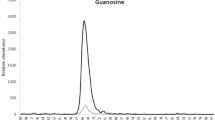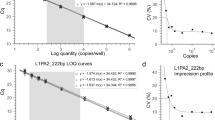Abstract
AICAR (5-amino-4-imidazolecarboxyamide ribonucleoside) arguably provides performance-enhancing properties even in the absence of physical exercise and, therefore, the substance is banned in elite sports since 2009. Due to the natural presence of AICAR in human blood and urine, uncovering the misuse by direct qualitative analysis is not possible. Entering the circulation, the riboside is immediately incorporated into red blood cells (RBCs) and transformed into the corresponding ribotide (5′-monophosphate) form. Within the present study, an analytical method was developed to determine AICAR-ribotide concentrations in RBC concentrates by means of liquid chromatography-tandem mass spectrometry. The method was validated enabling quantitative result interpretation considering the parameters specificity, precision (intra- and interday), linearity, recovery, accuracy (LOD/LOQ), stability and ion suppression. By analysing 99 RBC samples of young athletes, normal physiological levels of AICAR-ribotide were determined (10–500 ng/mL), and individual levels were found to be stable for several days. Employing in vitro incubation experiments with AICAR riboside in fresh whole blood samples, the ribotide concentrations were observed to increase significantly within 30 min from baseline to 1–10 μg/mL. These levels are considered conserved for the lifetime of the erythrocyte and, thus, the results of the in vitro model strongly support the hypothesis that measuring abnormally high AICAR-ribotide concentrations in RBC of elite athletes has the potential to uncover the misuse of this substance for a long period of time.





Similar content being viewed by others
References
Narkar VA, Downes M, Yu RT, Embler E, Wang YX, Banayo E, Mihaylova MM, Nelson MC, Zou Y, Juguilon H, Kang H, Shaw RJ, Evans RM (2008) Cell 134:405–415
Thevis M, Thomas A, Kohler M, Beuck S, Schänzer W (2009) J Mass Spectrom 44:442–460
Been J (2012) Velonation: http://www.velonation.com/News/ID/11395/Doping-AICAR-Telmisartan-and-the-need-for-vigilance.aspx#post-comments. Accessed 22 Apr 2013
Stokes S (2012) Velonation: http://www.velonation.com/News/ID/11406/Colombian-doctor-Beltran-Nino-arrested-with-AICAR-and-TB-500-doping-products.aspx. Accessed 22 Apr 2013
http://www.wada-ama.org/en/Science-Medicine/Prohibited-List/ (2013), Vol. 2013
Barre L, Richardson C, Hirshman MF, Brozinick J, Fiering S, Kemp BE, Goodyear LJ, Witters LA (2007) Am J Physiol Endocrinol Metab 292:E802–E811
Goodyear LJ (2008) N Engl J Med 359:1842–1844
Marie S, Heron B, Bitoun P, Timmerman T, Van Den Berghe G, Vincent MF (2004) Am J Hum Genet 74:1276–1281
Dixon R, Fujitaki J, Sandoval T, Kisicki J (1993) J Clin Pharmacol 33:955–958
Dixon R, Gourzis J, McDermott D, Fujitaki J, Dewland P, Gruber H (1991) J Clin Pharmacol 31:342–347
Thomas A, Beuck S, Eickhoff JC, Guddat S, Krug O, Kamber M, Schänzer W, Thevis M (2010) Anal Bioanal Chem 396:2899–2908
Bosselaar M, Smits P, van Loon LJ, Tack CJ (2011) J Clin Pharmacol 51(10):1499–58
Matuszewski BK, Constanzer ML, Chavez-Eng CM (2003) Anal Chem 75:3019–3030
Trufelli H, Palma P, Famiglini G, Cappiello A (2011) Mass Spectrom Rev 30:491–509
Guddat S, Solymos E, Orlovius A, Thomas A, Sigmund G, Geyer H, Thevis M, Schanzer W (2011) Drug Test Anal 3:836–850
Thomas A, Schänzer W, Delahaut P, Thevis M (2012) Methods 56:230–235
Thomas A, Geyer H, Schänzer W, Crone C, Kellmann M, Moehring T, Thevis M (2012) Anal Bioanal Chem 403:1279–1289
Kohler M, Thomas A, Walpurgis K, Schänzer W, Thevis M (2010) Anal Bioanal Chem 398:1305–13012
Saugy M, Robinson N, Saudan C (2009) Drug Test Anal 1:474–478
Acknowledgments
The study was conducted with the support of the World Anti-Doping Agency (WADA, grant #11C7MT) and the Federal Ministry of the Interior of the Federal Republic of Germany (Bonn, Germany).
Author information
Authors and Affiliations
Corresponding author
Additional information
Published in the topical collection Anti-doping Analysis with guest editor Christopher Harrison.
Rights and permissions
About this article
Cite this article
Thomas, A., Vogel, M., Piper, T. et al. Quantification of AICAR-ribotide concentrations in red blood cells by means of LC-MS/MS. Anal Bioanal Chem 405, 9703–9709 (2013). https://doi.org/10.1007/s00216-013-7162-0
Received:
Revised:
Accepted:
Published:
Issue Date:
DOI: https://doi.org/10.1007/s00216-013-7162-0




